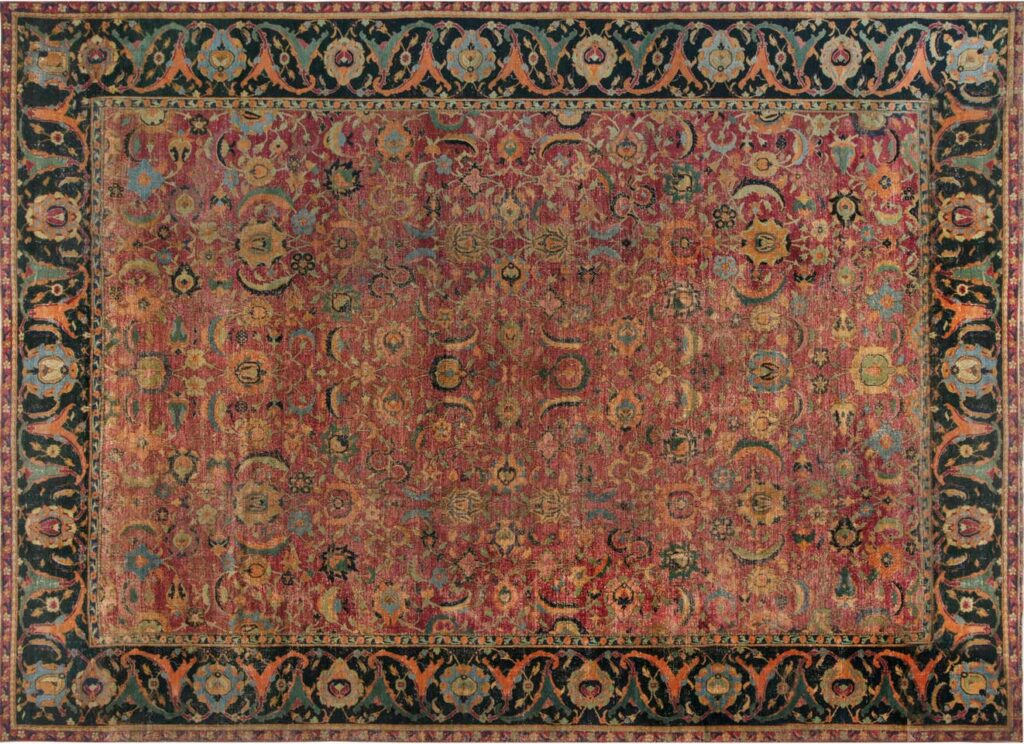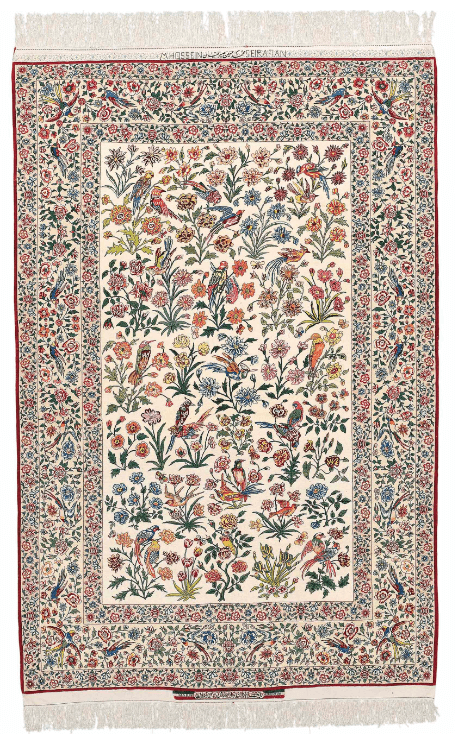Isfahan


Over time, carpets made for the palaces of the Safavids began to be used as gifts for the palaces of royalty in other countries. In this way, Isfahan carpets became very popular among European royalty and began to be ordered by their representatives in Isfahan.
Consequently, in the early 17th century, Isfahan carpets began to be recognized for their aesthetics and became emblems of wealth. In addition to royalty, European nobility began to acquire Isfahan carpets for their own use and to be given as gifts. At this time, there was a high demand for Isfahan carpets and it was the period at the height of their popularity in Europe and remained so until the middle of the 18th century. However, in 1772 the Afghan army invaded Persia, putting an end to the Safavids. Carpet making declined, not only in Isfahan, but elsewhere in the Persian empire. Thus ended the First Golden Age of Persian Carpets.


Figurative carpet signed Ahmad Esfhahani, 1900. The carpet has in its center the figure of Shah Abbas and around it the figures of four more kings of the Safavid dynasty. Sold at auction for £16,250.
It was only at the end of the 19th century that Isfahan reestablished its tradition of producing carpets, now inspired by the classic design of the Safavid era. The artists who made Isfahan carpets in the 19th century and those of the early 20th century continued the styles and techniques developed by their classical precursors, although often with the use of softer colors.
The high knot density antique rugs in which Isfahan excelled continued to be woven into the late 19th and 20th centuries, maintaining the original inspiration and attention paid to refinement and detail. The finest materials were used, including silk, lamb’s wool and natural dyes that made Isfahan rugs ancient collectibles and investment grade items.
The flowering of Isfahan carpets in the so-called Second Golden Age of Persian Carpets occurred through the work of two main artists. The two most important known master artists of the era before the 1930s were Agha Ahmad Ajam and Shoreshi. Both became respected for creating figurative designs and making high-quality rugs. The designs developed by Shoreshi feature the styles known as Shah Abbas, bushes and the tree of life. The drawings of the bushes and the tree of life are special and demonstrate the high artistic level of this master of the arts. The rugs feature various gardens with different animals, mainly birds, finely woven into both the main field and the edge of the rugs. Another design created by Shoreshi is the central medallion with Shah Abbas style on the background and edges. Shoreshi reintroduced this design in Isfahan which had not been used since Safavid times. But he did it in a more refined and delicate format, using ivory on the background. This style with a lighter colored background influenced many Isfahan artists who continue to employ this design to this day.
Agha Ahmadi Ajami was, after Shoreshi, the leading carpet artist in Isfahan in the pre-Seirafian period before the 1930s. His carpets became so famous and his influence was such that he influenced a whole generation of Isfahan carpets, being called ” Ahmadi” in his honor. However, those that contain his signature are extremely rare to find.
Ahmadi created several designs. A well-known style is the medallion featuring delicate Shah Abbas palm trees with flowers, leaves and vines. Another well-known Ahmadi rug style is the so-called tree of life design, with birds and animals. Ahmad’s Tree of Life rugs are of high quality and are valuable in the antique market today. However, his specialty was pictorial themes inspired by figures from Persian history and mythology.
During the second quarter of the 20th century, two notable masters of Isfahan carpet art were Hekmat Nejad and Haj Agha Reza Seirafian. Hekmat Nejad was an artist known for producing high-quality carpets with floral designs made on a limited scale. This artist’s production was made exclusively for the Pahlavi monarchy, to be used in their palaces and given as gifts from royalty to ambassadors and foreign officials. Hekmat Nejad rugs are signed in Farsi. They are considered true works of art and are valued in the market today as investment goods.

Isfahan signed Hekmat Nejad from 1940. Sold by the Austria Auction Company auction in Vienna for €22,500

Isfahan signed M. Hossein Seirafian, 1950. Sold at Christie’s London auction for £15,000
Haj Agha Reza Seirafian (1881-1975) was another master from Isfahan. The work started by this artist gave his family the highest reputation in the carpet industry. In 1939, this respected banker, investor and collector decided to enter the rug business. After purchasing two unfinished rugs from an artist who owed him money, Reza Seirafian finished the remaining work and embarked on a quest to improve the weaving standards of the time. Seirafian was an innovator who tripled the knot count from an average of 270 per square inch to over 500 knots. By using the best materials, designers and artists, the rug that became known as Seirafian innovated by creating a new standard of quality and elegance.
The quality of this master’s work is considered unsurpassed. Seirafian produced carpets with Shah Abbas motifs, scenic landscapes, delicate floral and hunting motifs. His figurative designs include a variety of birds, exotic animals, and human figures. The Seirafian carpet has a high level of quality due to its materials. The base is made of silk and the fur is made of lamb’s wool, from the animal’s chest area, the best quality of wool there is.
Seirafian’s seven children and 24 grandchildren followed in his footsteps and continued to produce rugs of the same caliber. Today, the name Seirafian is synonymous with luxury, exclusivity and high quality. For three generations and with almost a hundred years of tradition, the masters of the Seirafian family have produced carpets that bear their names and exceed the quality of the standards of the other masters of Isfahan. The legacy left by the masters of the Seirafian family will endure through the creation of their timeless art.

Figalli Oriental Rugs
We do not sell rugs. We bring rare works of art to your home in the form of rugs.
Our services
You are Protected
Copyright © 2023 Figalli Oriental Rugs, All rights reserved. Desenvolvido por Agência DLB – Agência de Marketing Digital em Porto Alegre


